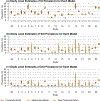A Bayesian multivariate meta-analysis of prevalence data
- PMID: 32510638
- PMCID: PMC7571488
- DOI: 10.1002/sim.8593
A Bayesian multivariate meta-analysis of prevalence data
Abstract
When conducting a meta-analysis involving prevalence data for an outcome with several subtypes, each of them is typically analyzed separately using a univariate meta-analysis model. Recently, multivariate meta-analysis models have been shown to correspond to a decrease in bias and variance for multiple correlated outcomes compared with univariate meta-analysis, when some studies only report a subset of the outcomes. In this article, we propose a novel Bayesian multivariate random effects model to account for the natural constraint that the prevalence of any given subtype cannot be larger than that of the overall prevalence. Extensive simulation studies show that this new model can reduce bias and variance when estimating subtype prevalences in the presence of missing data, compared with standard univariate and multivariate random effects models. The data from a rapid review on occupation and lower urinary tract symptoms by the Prevention of Lower Urinary Tract Symptoms Research Consortium are analyzed as a case study to estimate the prevalence of urinary incontinence and several incontinence subtypes among women in suspected high risk work environments.
Keywords: Bayesian methods; meta-analysis; missing data; prevalence; sensitivity analysis; urinary incontinence.
© 2020 John Wiley & Sons, Ltd.
Figures



References
-
- Arends LR, Vokó Z, Stijnen T. Combining multiple outcome measures in a meta-analysis: an application. Statistics in Medicine 2003;22(8):1335–1353. http://onlinelibrary.wiley.com/doi/abs/10.1002/sim.1370. - DOI - PubMed
-
- Bujkiewicz S, Thompson JR, Sutton AJ, Cooper NJ, Harrison MJ, Symmons DPM, et al. Multivariate meta-analysis of mixed outcomes: a Bayesian approach. Statistics in Medicine 2013. September;32(22):3926–3943. http://doi.wiley.com/10.1002/sim.5831. - DOI - PMC - PubMed
-
- Efthimious O, Debray TPA, van Valkenhoef G, Trelle S, Panayidou K, Moons KGM, et al. GetReal in network meta-analysis: a review of the methodology. Res Syn Meth 2016;7(3):236–263. - PubMed
Publication types
MeSH terms
Grants and funding
- U24 DK106786/DK/NIDDK NIH HHS/United States
- U01 DK106858/DK/NIDDK NIH HHS/United States
- U01 DK106786/DK/NIDDK NIH HHS/United States
- U01 DK106892/DK/NIDDK NIH HHS/United States
- R01 LM012982/LM/NLM NIH HHS/United States
- U01 DK106853/DK/NIDDK NIH HHS/United States
- U01 DK106893/DK/NIDDK NIH HHS/United States
- R21 LM012744/LM/NLM NIH HHS/United States
- U01 DK106908/DK/NIDDK NIH HHS/United States
- U01 DK106898/DK/NIDDK NIH HHS/United States
- T32 HL129956/HL/NHLBI NIH HHS/United States
- U01 DK106827/DK/NIDDK NIH HHS/United States
LinkOut - more resources
Full Text Sources
